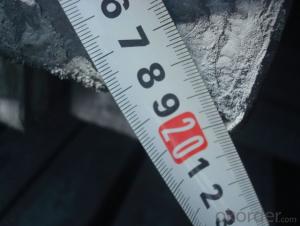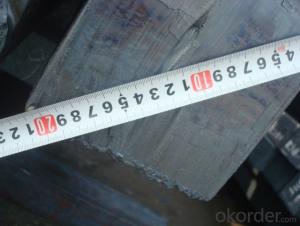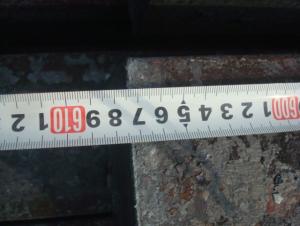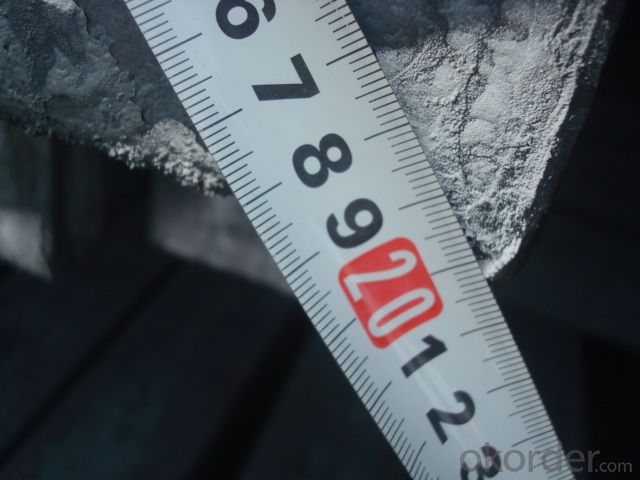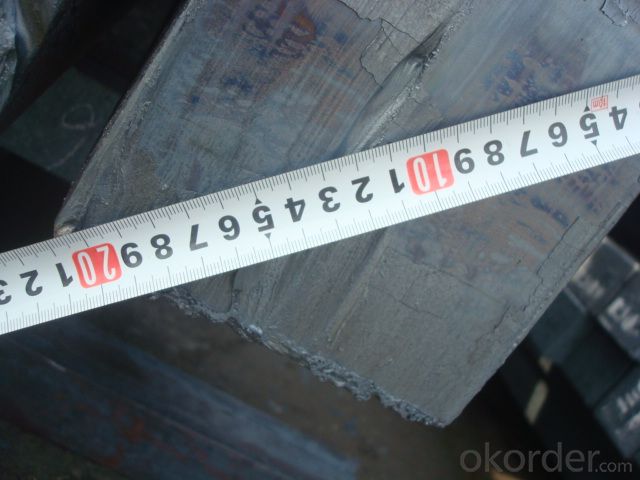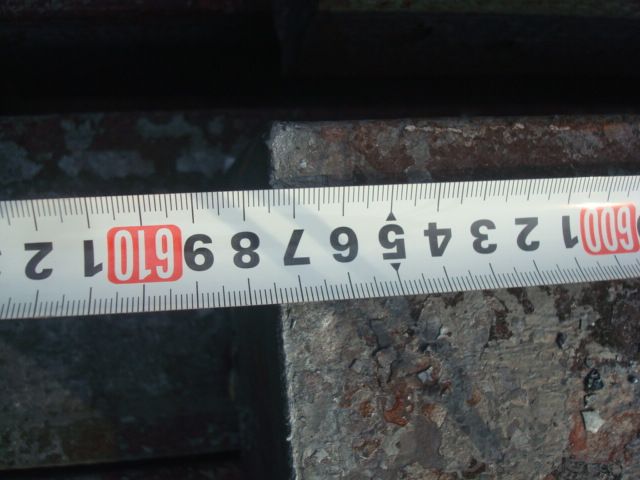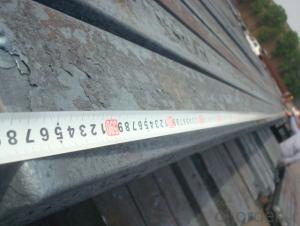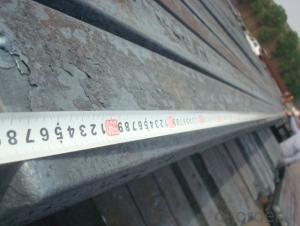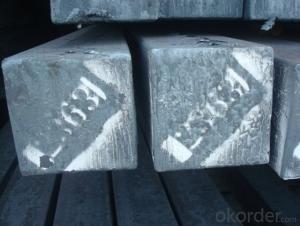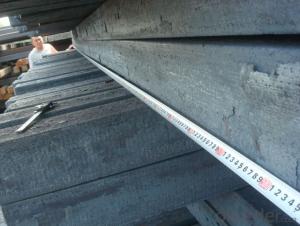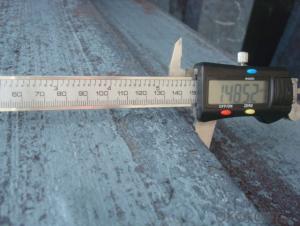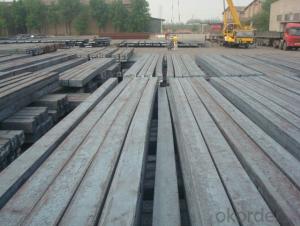Continue Casting Steel Billets/Blooms By Blasting Furnace
- Loading Port:
- Qingdao
- Payment Terms:
- TT OR LC
- Min Order Qty:
- 1000 m.t.
- Supply Capability:
- 10000 m.t./month
OKorder Service Pledge
OKorder Financial Service
You Might Also Like
Continue Casting Steel Billets/Blooms By Blasting Furnace
1.Structure of Continue Casting Steel Billets/Blooms By Blasting Furnace
Continue Casting Steel Billet Manufactured By Blasting Furnace is the raw material of all kinds of steel mill. Billet section of square, round, flat, rectangular and abnormity, etc Several, mainly related to shape of rolled products. Simple rolled section steel, choose cross section of square billet or rectangular billet. rolling The sector products such as flat steel, Angle steel, select the rectangular billet or slab. Had better profiled billet when production beams, channels, and in rolling process Lines and improve the yield. The raw material of round billet is the production of seamless tube.
2.Main Features of ContiContinue Casting Steel Billets/Blooms By Blasting Furnace.
Continue Casting Steel Billet Manufactured By Blasting Furnace section size should meet the requirements of rolling deformation and finished product quality, but also roll strength and biting condition of restrictions. General steel Billet section height H. And the roll diameter D The ratio of the ( namely H/D) Should be less than or equal to zero 0.5 . Length of steel billet by finishing temperature, Rolling time and the length of the product Or times ruler. When heated too long accident prone to bump the furnace wall of steel, too short, furnace bottom utilization rate is not high, influence the heating furnace production. For the production Choose a variety of steel and steel billet, should consider the affinities of billet, as far as possible in order to improve the productivity of the roughing mill, simplify the stock management of workshop.
3. Continue Casting Steel Billets/Blooms By Blasting Furnace Images
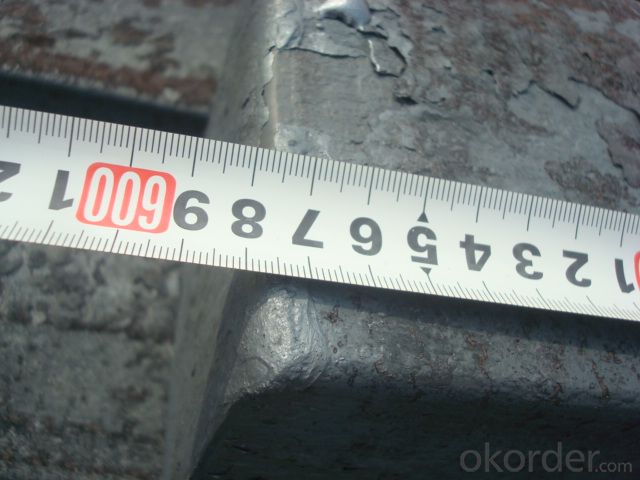
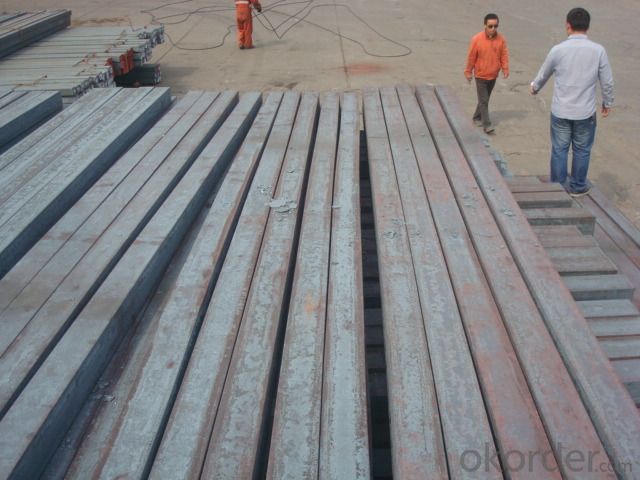
4. Continue Casting Steel Billets/Blooms By Blasting Furnace Specification
Slab: cross section width and height of the ratio of the larger, mainly used for rolling plate. Billet: equal cross section width and height, or a huge difference, mainly used for rolling steel, wire rod.
Material standard The editor Range of thickness: 150-240 - mm + / - 5 mm width range: 880-1530 - mm + / - 20 mm Length: 3700-10000 - mm + / - 500 - mm Cross-sectional size: 64 * 64; 82 * 82; 98 * 98; 124 * 124; 120 * 150; 152 * 164; 152 * 170 mm Length: 9000 mm Section of tolerance: billet: 1.0 + / - 2.0-1.0 + / - 1.0 mm slab: width: + / - 2.0 mm thickness: + / - 3.0 mm The length tolerance: + / - 200 mm Section diagonal tolerance: 3.5-8.0 MM Billet section size protrusions requirements: < 1242 mm, do not allow; > = 1242 mm, < = 2 mm 1242 mm, < = 3 mm Beheading (shear) extension deformation: < 1242 mm billet: no control; The slab: < = 15 mm Surface tilt: no more than billet section 0.1 Bending: every 1 m length is not more than 10 mm The distortion: length < = 5 m, < = 11. ; The length of the < = 7.5 M, < = 5. Material % 3 sp/PS chemical composition: C Mn Si S P
There are three shapes of the steel billets: square billet, slab, rectangular billet The Chinese billet, rectangular billet is mainly suitable for rolling hot rolled strip, building reinforced bar, Ordinary wire, high speed wire rod and various small profile. Of the slab are mainly used for rolling plate and hot coil sheet.
5.FAQ of Continue Casting Steel Billets/Blooms By Blasting Furnace
We have organized several common questions for our clients,may help you sincerely:
①How about your company?
A world class manufacturer & supplier of castings forging in carbon steel and alloy steel,is one of the large-scale professional investment casting production bases in China,consisting of both casting foundry forging and machining factory. Annually more than 8000 tons Precision casting and forging parts are exported to markets in Europe,America and Japan. OEM casting and forging service available according to customer’s requirements.
②How to guarantee the quality of the products?
We have established the international advanced quality management system,every link from raw material to final product we have strict quality test;We resolutely put an end to unqualified products flowing into the market. At the same time, we will provide necessary follow-up service assurance.
③How is the packaging and delivery?
Loose by Vessel and the delivery term is based on the the quantity and our factory’s schedule then.
- Q: What is the cost of a steel billet?
- The cost of a steel billet can vary depending on several factors such as the size, grade, and market conditions. Steel billets are semi-finished products that serve as raw material for various steel products. The price of a steel billet is typically quoted per metric ton. To determine the cost, one must consider the current market price of steel, which can fluctuate due to factors like supply and demand, international trade policies, and global economic conditions. Additionally, the grade of steel billet can impact the cost as different grades have varying levels of purity and specifications. It is essential to reach out to steel suppliers or consult market reports to get accurate and up-to-date information on the cost of steel billets. Additionally, other factors such as transportation and handling costs may also influence the final price.
- Q: What are the environmental impacts of steel billet production?
- Steel billet production, being a process that yields semi-finished steel products, can have diverse consequences on the environment. One notable impact is the release of greenhouse gases during the manufacturing of steel. This occurs when iron ore is melted, emitting carbon dioxide (CO2) into the atmosphere. CO2 is a significant contributor to global warming and climate change. Another environmental effect of steel billet production is the consumption of natural resources. The steel industry requires substantial amounts of water and energy to manufacture billets. The extraction and processing of raw materials like iron ore and coal can also cause the destruction of habitats and disruption of ecosystems. Moreover, the production of steel billets can lead to pollution of both air and water. Burning fossil fuels during the manufacturing process releases various pollutants, including sulfur dioxide (SO2) and nitrogen oxides (NOx), which contribute to acid rain and respiratory issues. Additionally, the discharge of wastewater from steel production can contain heavy metals and other contaminants, polluting rivers and harming aquatic life. Steel billet production also generates solid waste, such as slag and dust, which present waste management challenges. These waste materials may contain toxic substances, necessitating proper handling and disposal to prevent environmental contamination. Several measures can be taken to alleviate the environmental impacts of steel billet production. The adoption of cleaner technologies, such as energy-efficient furnaces and recycling processes, can help reduce energy consumption and emissions. Implementing rigorous environmental management systems and investing in pollution control technologies can also minimize air and water pollution. Additionally, promoting the use of recycled steel and sustainable sourcing of raw materials can aid in conserving natural resources and reducing the environmental footprint of steel billet production.
- Q: Can steel billets be used in the production of marine equipment?
- Yes, steel billets can be used in the production of marine equipment. Steel is known for its strength, durability, and corrosion resistance, making it a suitable material for marine applications. Steel billets, which are semi-finished products in the steel manufacturing process, can be further processed and transformed into various marine equipment components such as ship hulls, propeller shafts, rudders, and offshore structures. The high strength-to-weight ratio of steel makes it ideal for handling the demanding conditions encountered in marine environments, including exposure to saltwater, extreme temperatures, and mechanical stresses. Additionally, steel can be easily fabricated, welded, and machined, allowing for the customization and production of complex marine equipment designs. Overall, steel billets are a valuable raw material in the production of marine equipment due to their strength, durability, and suitability for marine applications.
- Q: What are the challenges faced in the production of steel billets?
- The production of steel billets encounters various obstacles. One major hurdle is the acquisition of raw materials. Typically, steel billets are created from iron ore, which must first be mined and processed. However, the availability and quality of iron ore can fluctuate, making it difficult to maintain a consistent supply. Another challenge arises from the energy-intensive nature of steel production. Converting iron ore into steel billets demands significant amounts of energy, primarily in the form of electricity and fossil fuels. Consequently, this results in high production costs and contributes to environmental concerns, including greenhouse gas emissions. In addition, the production of steel billets involves intricate metallurgical processes. The steel must be heated to high temperatures and undergo various treatments to achieve the desired properties. Ensuring consistent quality and meeting customer specifications can be problematic, as even slight deviations in the production process can impact the final product's performance. Maintaining a safe working environment poses a considerable challenge in steel billet production. The process involves handling heavy machinery, molten metal, and potentially hazardous chemicals. Effective safety measures and protocols must be implemented to safeguard workers and prevent accidents. Lastly, market dynamics and competition within the steel industry create hurdles in the production of steel billets. Fluctuating demand, changes in customer preferences, and price volatility can affect production planning and profitability. Steel producers must remain competitive by continuously improving efficiency, reducing costs, and adapting to market trends. In summary, the production of steel billets faces challenges related to raw material sourcing, energy consumption, metallurgical processes, safety, and market dynamics. Overcoming these obstacles necessitates a combination of technological advancements, efficient operations, and strategic decision-making to ensure a sustainable and successful production process.
- Q: What is the price range of steel billets?
- The price range of steel billets can vary depending on various factors such as the quality of the steel, market demand, and global economic conditions. However, on average, steel billets can range in price from $400 to $800 per metric ton.
- Q: What are the different types of shearing machines used for steel billets?
- There are several types of shearing machines commonly used for cutting steel billets. These machines are designed to provide precise and efficient cutting operations in the steel industry. Here are some of the different types of shearing machines used for steel billets: 1. Guillotine Shears: Guillotine shears are one of the most widely used shearing machines for cutting steel billets. They feature a stationary bed and a moving blade that moves vertically to cut through the material. Guillotine shears offer high cutting accuracy and are capable of cutting thick billets with ease. 2. Flying Shears: Flying shears, also known as rotary shears, are another popular type of shearing machine used for cutting steel billets. These machines have a rotating circular blade that cuts through the billet as it moves along the conveyor. Flying shears are known for their high cutting speed and can handle large volumes of billets. 3. Cold Shears: Cold shears are specifically designed for cutting steel billets at lower temperatures to prevent any heat damage to the material. These shearing machines use a hydraulic or mechanical system to apply force and cut through the billet. Cold shears are commonly used in industries where the steel billets need to be cooled down before further processing. 4. Rotary Shears: Rotary shears are typically used for cutting steel billets into smaller sections. These machines feature multiple blades mounted on a rotating drum, which cuts the billet into desired lengths. Rotary shears offer high cutting efficiency and are often used in industries where small-sized billets are required. 5. Hydraulic Shears: Hydraulic shears are versatile shearing machines that can be used for cutting various materials, including steel billets. These machines use hydraulic power to provide the necessary force for cutting through the billet. Hydraulic shears offer high cutting speed and can handle large-sized billets efficiently. Each type of shearing machine mentioned above has its own advantages and is suitable for specific applications in the steel industry. The choice of shearing machine depends on factors such as the size and thickness of the billet, required cutting accuracy, production volume, and other specific requirements of the steel processing operation.
- Q: What are the challenges faced in steel billet manufacturing?
- Steel billet manufacturing encounters various challenges. One of the primary obstacles is the attainment of consistent quality and uniformity in the billets. The billets must possess precise chemical composition and physical properties to meet the requirements of the end products. However, fluctuations in raw materials, like iron ore and scrap metal, can influence the billets' quality. Ensuring consistent quality throughout the production process is crucial but is difficult due to the variable nature of the raw materials. Another challenge lies in ensuring the appropriate heat treatment of the billets. Heat treatment is necessary to enhance the mechanical properties of the steel billets, but it demands precise control over temperature, time, and cooling rates. Any deviation from the recommended heat treatment process can lead to inconsistent mechanical properties, resulting in a decline in the overall billet quality. Furthermore, the production of steel billets involves intricate and energy-intensive processes. Manufacturing facilities must possess advanced equipment and technology to handle the high temperatures required for melting and casting the steel. The continuous casting process, commonly used for billet production, necessitates precise control over various parameters, such as casting speed and cooling rates. Maintaining the equipment and ensuring its proper functioning can be a challenge in itself. Moreover, environmental concerns present challenges in steel billet manufacturing. The process generates significant emissions of greenhouse gases, particulate matter, and other pollutants. Stricter environmental regulations and the need to reduce the carbon footprint of the manufacturing process require steel producers to invest in energy-efficient technologies and implement sustainable practices. Lastly, the market demand for steel billets can be volatile, posing challenges in production planning and inventory management. Demand fluctuations can result in overproduction or stockouts, impacting the overall efficiency and profitability of the manufacturing process. Overall, steel billet manufacturing encounters challenges related to maintaining consistent quality, achieving proper heat treatment, managing energy-intensive processes, addressing environmental concerns, and adapting to market dynamics. Overcoming these challenges necessitates continuous improvement, technological investments, and adherence to stringent quality standards.
- Q: How are steel billets used in the production of construction equipment?
- Steel billets are used as a primary raw material in the production of construction equipment, serving as the foundation for creating various components and parts. These billets are heated and molded into specific shapes through processes like forging or casting, enabling the creation of durable and robust structures. The resulting steel components, such as frames, chassis, and structural supports, provide the necessary strength and stability required in construction equipment, ensuring their ability to withstand heavy loads and harsh working conditions.
- Q: How are steel billets used in the manufacturing of construction machinery?
- Steel billets are an essential component in the manufacturing of construction machinery. These billets are large, semi-finished steel products that are commonly used as raw material in the construction machinery industry. They are typically produced through a process called continuous casting, where molten steel is poured into a mold to form a solid billet. Once the steel billets are produced, they undergo various manufacturing processes to shape them into the desired components of construction machinery. This includes forging, rolling, and machining. Forging involves heating the billets to a high temperature and then shaping them through the application of pressure, resulting in the formation of various parts such as gears, shafts, and axles. Rolling is another commonly used method, where the billets are passed through a series of rolling mills to reduce their size and shape them into specific forms, such as plates, bars, or sheets. These rolled billets can be further processed to create components like chassis, frames, or structural beams for construction machinery. In addition to forging and rolling, machining processes are also employed to shape the steel billets into intricate parts with specific dimensions. This involves using cutting tools to remove excess material and create precise shapes and features, such as holes, threads, or grooves. Machining is crucial for producing components like engine parts, hydraulic cylinders, or gearboxes for construction machinery. Overall, steel billets serve as the starting point for the manufacturing of construction machinery, providing the necessary raw material that is then transformed through various processes into the required components. The strength, durability, and versatility of steel make it an ideal material for construction machinery, ensuring the final product can withstand heavy loads, harsh environments, and demanding applications.
- Q: What are the main differences between hot-rolled and cold-rolled steel billets?
- Hot-rolled and cold-rolled steel billets differ primarily in their manufacturing processes and resulting steel characteristics. To produce hot-rolled steel billets, the steel is heated above its recrystallization temperature, typically around 1200°C (2200°F), and then rolled into the desired shape or size. This involves the use of large-scale machinery, such as rolling mills, which apply significant pressure to shape the steel. Consequently, hot-rolled steel billets have a rough and scaled surface. On the contrary, cold-rolled steel billets are created by further processing the hot-rolled steel. The hot-rolled steel is cooled to room temperature and then passed through a series of rollers at lower temperatures, usually below 1000°C (1832°F). This process offers more precise control over the dimensions and surface finish of the steel. As a result, cold-rolled steel billets exhibit a smoother and more polished appearance compared to their hot-rolled counterparts. Regarding physical and mechanical properties, hot-rolled steel billets generally possess higher yield strength but lower ductility compared to cold-rolled steel. This is due to the hot-rolling process causing strain hardening in the steel, resulting in increased strength but reduced ability to deform without breaking. In contrast, cold-rolled steel retains more ductility as a result of the controlled rolling process at lower temperatures. Another significant distinction lies in the dimensional accuracy of the two steel billet types. Hot-rolled steel billets are known to have larger dimensional tolerances, meaning there can be variations in their thickness, width, and length. Conversely, cold-rolled steel billets possess tighter dimensional tolerances, leading to more precise and consistent dimensions. In summary, the primary differences between hot-rolled and cold-rolled steel billets stem from the manufacturing process, surface finish, physical and mechanical properties, and dimensional accuracy. Understanding these disparities is crucial when selecting the appropriate type of steel billets for specific applications, as each type offers its own advantages and disadvantages.
Send your message to us
Continue Casting Steel Billets/Blooms By Blasting Furnace
- Loading Port:
- Qingdao
- Payment Terms:
- TT OR LC
- Min Order Qty:
- 1000 m.t.
- Supply Capability:
- 10000 m.t./month
OKorder Service Pledge
OKorder Financial Service
Similar products
Hot products
Hot Searches
Related keywords
